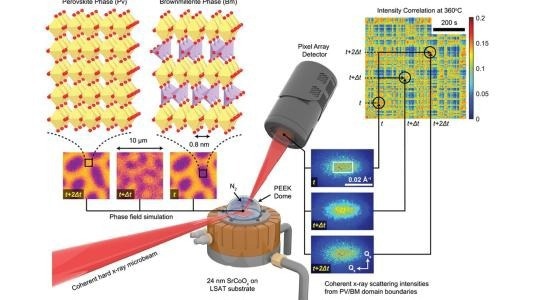Researchers are looking to the human brain as a blueprint for addressing computing hurdles in nanodevices and artificial intelligence (AI). However, achieving this goal necessitates materials capable of replicating our neural circuits at the smallest scale possible.
 This diagram illustrates how the researchers arrayed the APS to examine how the structure of a specific material, SrCoOx, changes when it is conducting an electrical current versus when it is not. Image Credit: from Advanced Materials.
This diagram illustrates how the researchers arrayed the APS to examine how the structure of a specific material, SrCoOx, changes when it is conducting an electrical current versus when it is not. Image Credit: from Advanced Materials.
AI is poised to revolutionize various technologies, ranging from solar panels to self-driving vehicles and in-body medical sensors. However, these technologies are already pushing the limits of present-day computers with regard to memory size, speed, and energy use.
Thankfully, AI, computing, and nanoscience scientists are actively addressing these challenges. They are using the human brain as a model to help them resolve those challenges.
The reason behind this is that the circuits, or neurons, in the human brain possess a critical advantage over present-day computer circuits: information can be stored and processed in the same location. This inherent capability makes them incredibly fast and energy-efficient.
Hence, researchers are currently investigating the use of nanomaterials, which are measured in billionths of a meter, to build circuits that function similarly to our neurons. To achieve this goal, however, researchers must gain a precise understanding of the atomic-level processes occurring within these nanomaterial circuits.
Recently, a research team, including researchers from the US Department of Energy’s (DOE) Argonne National Laboratory, introduced a groundbreaking method for precisely evaluating these processes. They utilized the Advanced Photon Source (APS), a DOE Office of Science user facility, to investigate the structural changes in a particular nanomaterial as it evolves from conducting an electrical current to not conducting, mimicking the “on” and “off” states in a neural circuit.
Within these materials, the conducting phase is regulated by imperfections known as “point defects” at the atomic level. Researchers can manipulate the concentration and position of these defects by applying strain on the nanomaterial, thereby altering the electron flow pathway. However, these defects are in constant motion, leading to changes in the material’s non-conducting and conducting regions. Until recently, studying this motion has proven to be exceedingly challenging.
There has been a lot of research about the occurrence and nature of defects in nanomaterials. But we knew very little about the dynamics of these defects when a material changes phase. We wanted to show that you can use X-rays to examine transitions between conducting and non-conducting phases in nanomaterials under conditions similar to those under which these materials will be used.
Dillon Fong, Materials Scientist, Argonne National Laboratory
The researchers showed how the APS can help facilitate this.
In their experiment, the scientists selected SrCoOx, a material known for its ability to readily transition between non-conducting and conducting (insulating) phases.
To observe these fluctuations at the nanoscale, they employed X-Ray photon correlation spectroscopy (XPCS). This technique was made possible by the highly coherent X-Ray beams generated by the APS. XPCS allows for the direct measurement of the speed at which the material oscillates between different phases at the atomic level, even when these oscillations are hardly detectable.
The XPCS measurement would not be possible without the coherent X-ray beam from the APS.
Qingteng Zhang, Assistant Physicist, Advanced Photon Source, Argonne National Laboratory
Zhang added, “In addition, it is important that we take the measurement under the same conditions that the material will operate under. This allows us to learn how the material will behave while performing its intended function. However, such environmental control usually requires sealing the sample in a chamber or a dome. This is where the highly penetrating X-ray beam from the APS is extremely helpful. Because while the chamber window or the dome shell is opaque to visible light, we can make either one completely transparent to the X-rays.”
The current upgrade of the APS will boost the brightness of its X-Rays by up to 500 times when completed in 2024. This enhancement will not only accelerate measurement speeds but also improve the quality of coherent X-Ray methods such as XPCS. This could open up unparalleled scientific possibilities for scientists worldwide.
This is truly exciting for Panchapakesan Ganesh, a scientist at DOE’s Oak Ridge National Laboratory (ORNL), who guided the theoretical efforts of the study together with his colleagues Vitalii Starchenko, ORNL, and Guoxiang Hu, currently an assistant professor at Georgia Tech.
High-quality data from experiments like these are critical to our ability to develop theories and build models that can capture what happens in nanoelectronic materials when they go from conducting to non-conducting phases.
Panchapakesan Ganesh, Study Lead Author and Researcher, Oak Ridge National Laboratory, Department of Energy
Ganesh added, “For example, we need to learn how energy dissipates in these systems if we are going to develop nanodevices that approach the energy efficiency of our brains. No single computational approach can solve this type of problem on its own. We need the best inputs from both the experimental and computational science sides to advance this nanoscale understanding. Our integrated approach is a perfect example of that, and we think it will spur more research in this exciting new field.”
The study was financially supported by the DOE Office of Basic Energy Sciences. Fong and his fellow scientists illustrate the experimental details and their results in the journal Advanced Materials. In addition to Fong and Zhang, other Argonne authors include E. M. Dufresne, H. Zhou, Y. Dong, A. R. Sandy, G. E. Sterbinsky, G. Wan, I. C. Almazan, and H. Liu.
Journal Reference:
Zhang, Q., et al. (2024) Intermittent Defect Fluctuations in Oxide Heterostructures. Advanced Materials. doi:10.1002/adma.202305383.